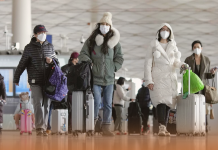On Thursday, the WHO (World Health Organization) published a novel scientific study explaining how the COVID-19 can transmit from one body to the other, including via the air during specific medical methods, and possibly via the air in crowded indoor spaces.
.@WHO releases a new scientific report detailing how the coronavirus can pass from one person to the next — including through the air during certain medical procedures, and possibly through the air in crowded indoor spaces https://t.co/hlvUeGmuU3
— CNN Philippines (@cnnphilippines) July 9, 2020
The study describes that, to the best of their understanding, the Coronavirus is mainly blowout through respiratory droplets, but still, there are several unanswered questions about airborne transmission, and more researches are immediately required.
The study arrived just days after when the publication of a letter on Monday passed by 239 scientists that forced the agency to be more forthcoming that people can get the COVID-19 from droplets moving in the air.
The novel WHO study said about the Coronavirus that airborne movement of the Coronavirus could happen in health care settings, where particular medical methods, called aerosol developing methods, create very small droplets known as aerosols. Some of the breakout studies connected to indoor crowed spaces have proposed the possibility of aerosol movement/transmission, joined with droplet transmission, such as, during choir practices in fitness classes or in restaurants.

Source: Web
But the latest evidence suggests that movement of Coronavirus occurs basically through people’s direct or indirect contact, or close contact with COVID-19 infected people via infected secretions including respiratory sections or saliva or via the respiratory droplets, which came out when a COVID patient sneezes, coughs, sings, or talks, the study says. Furthermore, respiratory droplets from virus-infected persons can even land on surrounding objects.
The official website of WHO also identified that there had been reported blowouts of Coronavirus in many closed settings, including nightclubs, restaurants, places for worship, and work frames where someone may be talking, singing, or shouting. Moreover, in these blowouts, aerosol transmission, specifically in that indoor places where there are gatherings and not properly ventilated places where COVID-19 infected people spend long hours with other colleagues, can’t be ruled out. Besides this, more researches are required immediately to inspect such cases and assess their importance for the transmission of Coronavirus.
An assistant professor and specialist, Brittany Kmush, in infectious diseases at New York’s Syracuse University, said that there is a difference between the droplets ejected when people cough or sneeze and transmit Coronavirus compared with aerosolized droplets.





